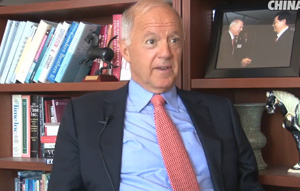Going back to root causes
Updated: 2013-06-13 10:02
By Deng Zhangyu (China Daily)
|
|||||||||||
 |
|
Liu Dazhong, 70, Liu Yiheng's father, visits the ruins of the family's root carving factory. |
 |
|
 |
He says a piece of quality wood can produce from one to several carvings depending on the size and shape.
Not far away from Wang's shop is one of the biggest root carving factories in Lushan - Daziran.
The factory's four-storey exhibition hall built along a river is on the verge of collapsing. Ruined root carvings were scattered everywhere.
Owner Liu Yiheng had learnt to carve from his father while still a teenager. It is a family business and he is now the fourth generation.
"Lushan is known for its root carving arts and crafts. The revenue from the whole industry reached 1 billion yuan last year," says Liu, who is also the chairman of the Root Carving Association of Lushan.
The art of carving dates back to the Eastern Han Dynasty (AD 25-220). At that time, the material used was mainly stone, but due to the rich store of rare ebony buried underground and in the rivers in Sichuan province, people turned to root carving. In recent years, the rareness of the wood and the excellence of the craftsmanship led to increased popularity for Lushan ebony carvings.
Liu's factory has more than 80 workers, among whom less than 20 are skilled craftsmen. Now most of them have returned home to rebuild their houses and only those living nearby stayed to help repair the factory.
"A penholder was priced at 30,000 yuan. Now it's broken. After we repair it, it will cost less than 10,000 yuan," says Liu.
The penholder he was referring to is made with the most precious of the ebonies - jinsi nanmu, also called golden thread wood for its fine golden grain. It is always in much demand.
Luo Zhirong is dedicated to searching out hidden and buried pieces of jinsi nanmu. She says the precious woods are frequently found in paddy fields and deep riverbeds. But it is the rare day when one can find a good specimen.
"If we are lucky to find one, we can sell it for half a million yuan," says Luo, standing besides her temporary tent. Her house at the county center is too damaged to live in.
 Luo says the quake stopped her search. She has no house to live in, so for the next months at least, building a new house is on top of her agenda.
Luo says the quake stopped her search. She has no house to live in, so for the next months at least, building a new house is on top of her agenda.
Along the street where 230 root carving shops congregate, only a few shops have opened for business, even though they are still pretty much in shambles.
"We may have to wait for at least half a year or even one year for full recovery, but we must face disaster with confidence," says Liu Yiheng, the owner of Daziran. Both of his two factories were significantly damaged, but he decided to stay open for business.
"Opening my shop is to send out a message of confidence to others," says Liu.
Related Stories
Experts redirect water to curb post-quake tragedies 2013-05-23 17:56
Yingxiu five years on 2013-05-20 15:18
Wenchuan Earthquake Memorial Museum officially opens to public 2013-05-10 11:36
Sichuan tourism hit hard by quake 2013-04-28 17:44
Shaolin monk doctors assist earthquake victims 2013-04-27 10:03
Today's Top News
Lifetime award for Jackie Chan
Spacecraft to dock
with Tiangong-1
Desert oasis
China's wine probe sparks worries
Teach children to avoid abuse: experts
Registry to open for organ donors
KMT officials begin three-day visit to mainland
Surveillance program a test of ties
Hot Topics
Lunar probe , China growth forecasts, Emission rules get tougher, China seen through 'colored lens', International board,
Editor's Picks

|

|

|

|

|

|





